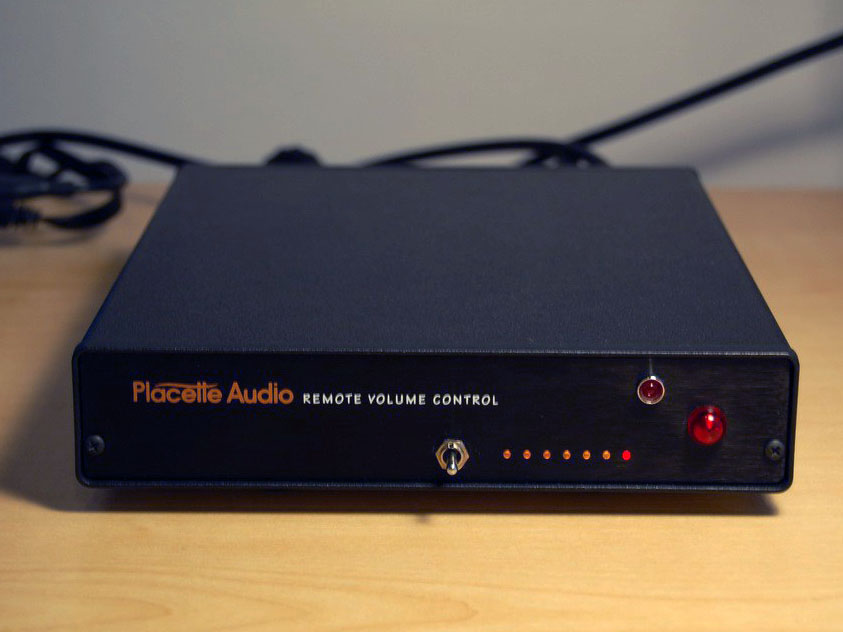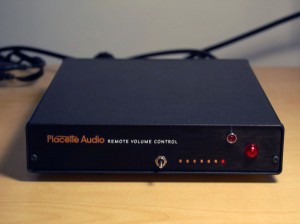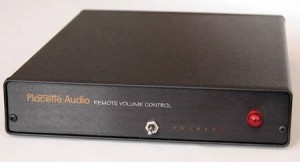Specifications:
- Connections: 1 set unbalanced inputs; 1 set unbalanced outputs; DC power connector. Controls: Remote supplied (Magnavox universal), toggle switch on face plate for manual volume adjustment.
- LED’s indicate volume output in a binary fashion. The output LED’s are fairly dim so they don’t distract.
- Dimensions: approximately 2″ high, 7.5″ wide and are 10″ deep.
- Retail Price: $1,000
The Placette Audio RVC is a passive preamplifier with only one input and one output. As such, it is ideal for the user who has only one source component or for someone who wishes to add remote volume control capability to an existing preamp that doesn’t have it. Although passive, the RVC provides a non-inductive load due to high quality resistors that are used throughout the volume control circuits. In other words, the RVC allows the sound to come through in fully, unimpeded by capacitors, tubes, and other parts found in traditional preamps, all of which affect the signal. The RVC uses a 125-step volume control built with very expensive Vishay S-102 resistors.
Placette Audio RVC review
According to Placette Audio, the sonic value of the Vishay S-102 is well known but the cost is so high that some builders use them only in certain parts of the attenuators. However, the only way to get the clarity, purity, and transparency that these resistors are known for is to use them exclusively in every part of the audio circuit or control. The Vishay resistors pass along the audio signal intact, unlike any other resistor.
Another important factor about the RVC is that it provides a constant 9K ohms input impedance at every volume level. This means your source always sees the same load and delivers an undistorted signal to your amplifier, which keeps it from sounding different at different volume settings.
Build: Looks better than it photographs. Nice build quality, heavier than I thought it would be, top notch RCA jacks on the rear, substantial DC power supply (not a wall wart, but a box style that sits on the floor). The power supply has a DIN style connector. Very simple/elegant, yet sparse in appearance
Observations:
Forget what you may have experienced in the past running your system passively: anemic dynamics and overly sterile presentation. The Placette is a definite departure from the norm. Have you ever heard a component so satisfying, that you didn’t want or feel the need to share your discovery? Initially, I felt like I couldn’t articulate with any degree of credibility, what this level of component deserves. The Placette was so musically “right” I felt no desire to justify its existence. So, in that light, here are some notes from my listening sessions:
Exceptionally clean, musical, neutral, and airy; tons of space around performers. Every instrument, sound, and vocal is presented in a fashion that doesn’t mask anything. Details are right there, no need to listen for them. Realistic sound plane that creates accurate soundstage depth/width.
Anchored center soundstage, perfect balance of channels, no moving or shifting of performers. Delineated vocals and instruments, regardless of output level. Excellent tonal accuracy, organic, textured, and three dimensional. Sweeping dynamics within a black background. Volume increases sweep across the entire spectrum of sound; the music just gets larger and larger. Everything moves up in level as a whole, very linear. Bass, midrange, treble, are simply reference level. Bass is deep, controlled, impactful; midrange has an organic texture and 3 dimensional character that is incredibly real; and treble is superbly defined and simply glorious. Low level listening loses nothing; impactful, satisfying, smooth, and articulate.
Some nitpicks to share: (1) a $1,000 passive should have a dedicated (built specifically for the unit) remote. I think the inclusion of a pre-programmed universal remote is borderline cheesy. (2) Though it doesn’t matter to me personally, I’m sure many would prefer a numerical representation of the output level, rather than the hokey binary display. (3) The RVC does not have a “MUTE” function, but it does turn down very quickly by holding the volume button down. These are all minor quibbles, but I felt they should be pointed out.
I couldn’t be more pleased with it. The RVC is an outstanding product and it’s synergy with my Benchmark DAC is excellent. The music has a very easy character to it that is very intoxicating. It’s incredible how they pulled off a more listenable, smooth sound–and at the same time, far more detailed and articulate. It’s even doing quite well with my “crappy CD’s test,” a collection of very poorly engineered/sounding CD’s.
As I peeled through more of my music collection, I liked this passive more and more. I can’t get over the linearity of frequencies as the output is increased. With active preamps I was accustomed to treble and voices being pushed in front at higher volumes, giving the music an edgy, exhausted/compressed sound. No such thing with the Placette. Even when I push the system hard, it never gets fatiguing or anything near edgy–it just “blooms” larger and larger. Nothing gets washed out, all the detail is there just like moderate listening levels. I had Sara Evans’ “Restless” playing at concert levels, and it was breathtaking.
I’ve done many upgrades, tweaks and changes, some of them bringing some nice (albeit subtle) changes to my system. There’s nothing subtle about the Placette. The RVC does tons of wonderful things, all by simply getting out of the way, in all of the correct ways. I’m not an electrical engineer, but I suspect the Vishay arrays and their implementation in this line stage are creating the magic by controlling input impedance so carefully, the music’s neutrality/linearity is maintained to the ‘nth degree. Is it worth the $1,000 admission fee? Absolutely. Two-channel fans you owe it to yourself to audition a Placette.
Related equipment (in order of connection):
- CEC CD-3300 transport,
- Belden 1694A digital coaxial cable, Benchmark DAC1,
- Kimber Hero 1mtr IC, Kimber Hero 0.5mtr IC, Parasound HCA-1500A,
- Kimber 8TC,
- Energy C-9 speakers
from affordableaudio, By Stephen Rose


